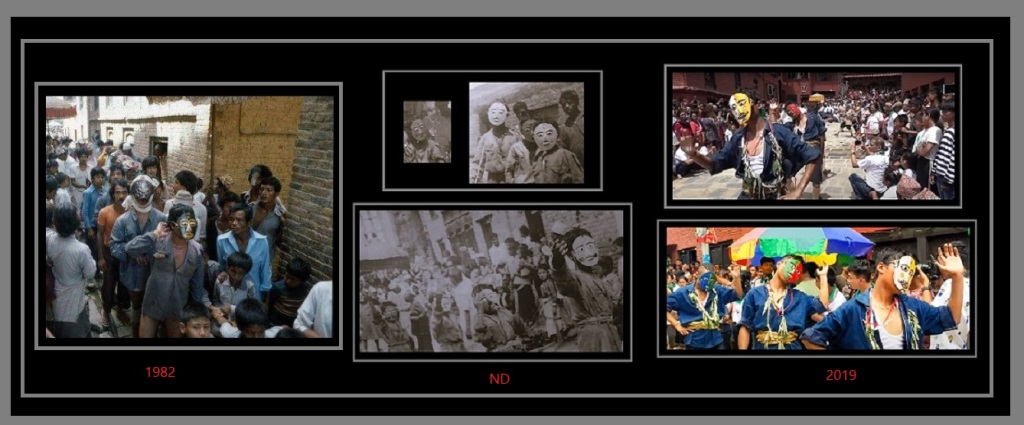ETHNOFLORENCE
INDIAN AND HIMALAYAN
FOLK AND TRIBAL ARTS
***
(I)
Indian and Himalayan Folk and Tribal Arts
A Selected Bibliography
BLOCK PRINTS FROM INDIA FOR TEXTILES
वस्त्रों के लिए भारत से प्रिंट के लिए ब्लॉक
by Albert Buell Lewis
XXIV Plates

Photo credit of https://archive.org/details/blockprintsfromi01lewi/page/6/mode/2up / Photo composition by Ethnoflorence
FIELD MUSEUM OF NATURAL HISTORY
Chicago
1924

Photo credit of https://archive.org/details/blockprintsfromi01lewi/page/6/mode/2up / Photo composition by Ethnoflorence
BORDER DESIGN ON THE END OF A WOMAN’S CLOTH

Photo credit of https://archive.org/details/blockprintsfromi01lewi/page/6/mode/2up / Photo composition by Ethnoflorence
In this design the black and red have been stamped, wlhile the yellow and green have been put in by hand. Ten different blocks have been used, separate impressions of nine of which are shown on Plates III and IV. That used for band is shown in Fig. 5. Plate IV: those for bands and 4 in Figs. I and 2, Plate III; for band 3, Figs, 1 & 2, and 4, Plate IV; for band 5. Figs. 3 and 4. Plate III; and for band 6, Fig. 3, Plate IV. The red dots of band 6 were printed by a narrow block which is not shown. This border is a fair example of the ordinary work done in cotton printing, neither the best nor the worst. In most cases the places where the impressions join can be readily seen.

Photo credit of https://archive.org/details/blockprintsfromi01lewi/page/6/mode/2up / Photo composition by Ethnoflorence
Fig. 1
This block shows the same design as Fig. ,l, Plate III, but is a different block from the one from which that impression was made. The holes at the bottom of the cut-out design go through to the top of the block. The design is bordered by a thin wood partition, which shows lighter than the rest of the surface. This part of the block has also been hollowed out, except for partitions every so often, and a fibrous mass firmly packed into the cavities thus formed. One of the cavities has lost its packing.
Fig. 2
The design on this block is shown in Fig. 1 Plate XX.

Photo credit of https://archive.org/details/blockprintsfromi01lewi/page/6/mode/2up / Photo composition by Ethnoflorence
A row of holes has been bored through the block from end to end, and another from side to side, and into these the small holes from the cut-out design open. The depth to which the design is cut is clearly shown on the side. The handle is part of the same piece of wood, as is usually the case, though occasionally it is cut out of a separate piece and pegged on.

Photo credit of https://archive.org/details/blockprintsfromi01lewi/page/6/mode/2up / Photo composition by Ethnoflorence
BLOCK PRINTS FROM INDIA—TWO-COLOR DESIGNS.
While the colors used for these designs may vary, the fine-cut designs with narrow lines are usually printed in black, and the heavier masses in red. The lack of perfect registration of the two colors is in the original blocks, and the agreement is at least as close as in ordinary cotton printing.

**
(II)
THE MASKING TRADITION IN TRIBAL INDIA AND HIMALAYA
34 living traditions explored in the course of this new research program devoted to the masked festivals of the Himalayan region and the Indian subcontinent.
A concise and unique methodology.

Hundreds of masks have already been taken into consideration, identified, localized and often explained in their meaning & unique iconography.
The materials are well represented and explained through the visual explanatory photo compositions Ethnoflorence’s style.

© Old Sherpa encrusted patina mask – Photo & Composition by Ethnoflorence
***
INDIAN AND HIMALAYAN BIBLIOGRAPHY
AN EXPLICATED ICONOGRAPHY
ETHNOFLORENCE SELECTION
DIE SAMMLUNG LUIGI BLESIO
a 2003’s Monographic Publication https://issuu.com/hanswarnitz/docs/sammlung_luigi_blesio
by
BENGHT FOSSHAG

Photo credit of Benght Fosshag – Photo Composition by Ethnoflorence

Photo credit of Benght Fosshag – Photo Composition by Ethnoflorence
*
























































































































































































